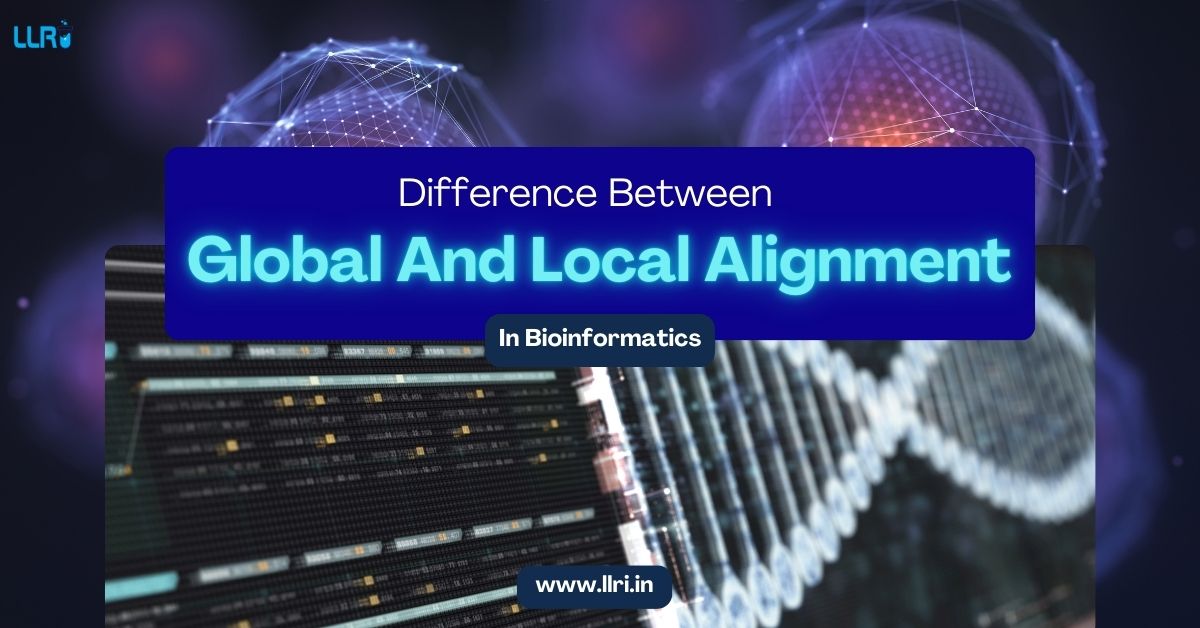Difference Between Global And Local Alignment: Bioinformatics is an exciting field that bridges biology and computational science, helping researchers uncover hidden patterns in biological data.
One of the core tasks in bioinformatics is sequence alignment, which helps scientists identify similarities and differences between sequences. But did you know that sequence alignment is broadly classified into two categories? These are global alignment and local alignment.
Overview:
- Global alignment covers the entire sequence length, while local alignment focuses on similar subsequences.
- The difference between global and local alignment lies in their scope, algorithms, and applications.
- What is alignment in bioinformatics? It’s the foundation for understanding genetic and protein relationships.

Alignment in Bioinformatics
In simple terms, alignment in bioinformatics refers to the method of comparing two or more biological sequences to identify similarities and differences. These alignments help scientists detect functional, structural, and evolutionary relationships. The two main types of alignment techniques are global alignment and local alignment.
Why Is Alignment Important in Bioinformatics?
Alignment serves as the foundation for numerous bioinformatics applications:
- Disease research: Identifying mutations linked to genetic disorders.
- Drug discovery: Understanding protein interactions for targeted therapies.
- Evolutionary studies: Tracing the lineage and evolution of genes and organisms.
If you’re looking to master bioinformatics techniques, pursuing a professional course can help. Institutions like LLRI offer industry-recognized training in bioinformatics and clinical research, empowering you with the skills to excel in this field.
What Is Global Alignment in Bioinformatics?
Global alignment in bioinformatics focuses on aligning sequences from end to end. This method is particularly useful when the sequences being compared are similar and of roughly the same length.
Key features of global alignment:
- Compares sequences in their entirety.
- Best suited for sequences with similar lengths.
- Identifies conserved regions across the full sequence.
For example, when comparing two closely related species, global alignment can reveal subtle differences across their genomes. Tools like the Needleman-Wunsch algorithm are commonly used for this purpose.
Global alignment is ideal for analyzing highly similar sequences, as it helps identify differences across the entire sequence length.
Example: Consider two sequences:
- Sequence A: AGCTGAC
- Sequence B: AGCT-AC
A global alignment would look like this:
AGCTGAC
AGCT-AC
What Is Local Alignment in Bioinformatics?
In contrast, local alignment in bioinformatics searches for regions of similarity within parts of the sequences, ignoring the rest. This approach is particularly beneficial when sequences vary significantly in length or contain many differences.
Key features of local alignment:
- Focuses on finding the best-matching segments.
- Ideal for sequences of differing lengths.
- Useful for identifying functional domains or motifs.
For example, local alignment is often used to compare a short DNA sequence (query) against an entire genome database to identify potential matches. The Smith-Waterman algorithm is widely used for local alignment.

Local alignment shines when working with sequences that share small regions of similarity, even if their overall structures differ significantly.
Example:
Consider the same sequences:
- Sequence A: AGCTGAC
- Sequence B: TCTGA
A local alignment would focus on the region with the highest similarity:
AGCTGAC
–CTGA-
What are the Differences Between Global and Local Alignment?
Now that we have explored their definitions, let’s explore the differences between global and local alignment:
| Aspects | Global Alignment | Local Alignment |
| Definition | Aligns sequences from start to finish. | Aligns sequences within specific regions. |
| Use Case | Similar sequences of the same length. | Dissimilar sequences or different lengths. |
| Key Algorithm | Needleman-Wunsch | Smith-Waterman |
| Output | Covers the full length of the sequences. | Focuses on matching segments. |
What are the Applications of Global and Local Alignment in Bioinformatics?
1. Global Alignment:
- Comparing two genomes of closely related species.
- Identifying large-scale evolutionary changes.
2. Local Alignment:
- Searching for conserved motifs or functional domains.
- Identifying gene families and protein structures.
For example, a clinical research training center may use local alignment tools to detect disease-causing mutations in specific genes. This practical application underpins much of modern clinical research.
Choosing the Right Approach: Global or Local Alignment?
So, how do you choose between global and local alignment? Ask yourself these questions:
- Are your sequences of similar length and overall similarity? Use global alignment.
- Are you looking for conserved regions within sequences of varying lengths? Opt for local alignment.
For example, genome-wide studies often use global alignment, whereas protein domain identification relies on local alignment.
Why Choose LLRI for Bioinformatics and Clinical Research Training?
- Curriculum: Our programs, such as the clinical research course, provide in-depth knowledge about sequence alignment and other bioinformatics tools.
- Affordable Clinical Research Course Fees: We ensure our courses are accessible to aspiring professionals.
- Exposure: Hands-on training with advanced tools is part of our clinical research training programs.
- Experienced Faculty: Learn from experts in the field at a premier clinical research training center.
Whether you’re looking to advance your career in clinical research or bioinformatics, LLRI is your gateway to success.
On A Final Note…
The difference between global and local alignment lies in their approach, use cases, and applications. Both are indispensable tools in bioinformatics, enabling groundbreaking discoveries in genetic research and clinical studies. By enrolling in a clinical research course at LLRI, you can gain the expertise to excel in this rapidly growing field.
Don’t just follow the trends—lead them. Join the best institute for PG Diploma in Clinical Research and embark on a journey that blends technology and biology to transform lives.

